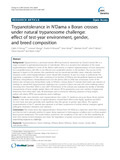Trypanotolerance in N¿Dama x Boran crosses under natural trypanosome challenge: effect of test-year environment, gender, and breed composition

View/
Date
2012-10-17Author
Orenge, Caleb O
Munga, Leonard
Kimwele, Charles N
Kemp, Steve
Korol, Abraham
Gibson, John P
Hanotte, Olivier
Soller, Morris
Type
Journal ArticleMetadata
Show full item recordAbstract
Abstract
Background
Trypanosomosis, a protozoal disease affecting livestock, transmitted by Glossina (tsetse) flies is a major constraint to agricultural production in Sub-Saharan Africa. It is accepted that utilization of the native trypanotolerance exhibited in some of the African cattle breeds to improve trypanotolerance of more productive but susceptible breeds, will offer a cost effective and sustainable solution to the problem. The success of this approach is based on the premise that quantitative trait loci previously identified under relatively controlled situations confer useful trypanotolerance under natural field situations. As part of a study to authenticate this hypothesis, a population of 192 cattle, consisting of six batches of N’Dama and Kenya-Boran backcross animals [(N’Dama x Kenya-Boran) x Kenya-Boran] born over the period 2002 to 2006 was constructed. Some of the batches also included pure Kenya-Boran cattle, or N’Dama x Kenya- Boran F1 animals. Each batch was exposed as yearlings to natural field trypanosomosis challenge over a period of about one year; the entire challenge period extending from December 2003 to June 2007. Performance of the animals was evaluated by weekly or biweekly measurements of body weight, packed blood cell volume (PCV), parasitemia score, and number of trypanocide treatments. From these basic data, 49 phenotypes were constructed reflecting dynamics of body weight, packed cell volume (PCV) and parasitemia under challenge.
Results
Females were distinctly more trypanotolerant than males. F1, backcross and pure Kenya- Boran animals ranked in that order with respect to trypanotolerance. Overall batch effects were highly significant (p<0.001) for most traits, and were generally more significant than the gender or genetic type effects. The superior trypanotolerance of the F1 animals was expressed in all three components of animal defense strategies against pathogens: Avoidance resistance, and tolerance.
Conclusions
The results show that trypanotolerance derived from the N’Dama is expressed under field conditions; and that the trait is primarily additive in nature, being expressed in heterozygous condition and in a three-quarters Boran genetic background. The results further, underscore the complexity of the trait in the field manifesting all three host disease-control strategies, and show the importance of gender and local environmental conditions in determining response to challenge.
URI
http://dx.doi.org/10.1186/1471-2156-13-87http://erepository.uonbi.ac.ke:8080/xmlui/handle/123456789/14672
